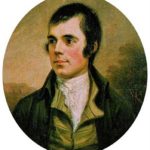 It would be no exaggeration to say that Robert “Robbie” Burns (1759-1796) was the Elvis Presley of nineteenth-century Scotland. Even his own day, his popularity was extraordinary. As a self-educated man from rural, agricultural Scotland, Burns wrote poetry that spoke to and of the people and also captured the attention of the upper classes. His interest in folk culture came at a time when other Europeans were beginning to turn to native influences instead of seeing the ancient world (Greece and Rome) as the epitome of civilization. And his use of the Scots language in much of his poetry fueled the movement to preserve that language and the culture of the Lowland Scots. To many he seemed to embody the essence of what it was to be Scottish, and adulation of Robert Burns and all that he seemed to stand for became a cult in Europe, America, and all around the world that persists to this day. We’ll examine the man, the poetry, and the myth, and we’ll try to discover what Burns’s poetry has to offer two and a quarter centuries after his death.
It would be no exaggeration to say that Robert “Robbie” Burns (1759-1796) was the Elvis Presley of nineteenth-century Scotland. Even his own day, his popularity was extraordinary. As a self-educated man from rural, agricultural Scotland, Burns wrote poetry that spoke to and of the people and also captured the attention of the upper classes. His interest in folk culture came at a time when other Europeans were beginning to turn to native influences instead of seeing the ancient world (Greece and Rome) as the epitome of civilization. And his use of the Scots language in much of his poetry fueled the movement to preserve that language and the culture of the Lowland Scots. To many he seemed to embody the essence of what it was to be Scottish, and adulation of Robert Burns and all that he seemed to stand for became a cult in Europe, America, and all around the world that persists to this day. We’ll examine the man, the poetry, and the myth, and we’ll try to discover what Burns’s poetry has to offer two and a quarter centuries after his death.
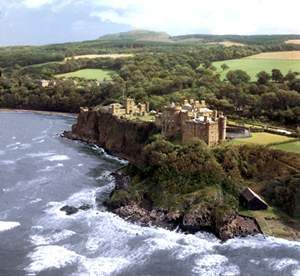
The first part of our sojourn in Scotland was planned around Burns’s life and legacy, but we start with a famous Scottish Castle and incredible scenery. After taking the ferry from Ireland to Scotland, we’ll visit one of Scotland’s most stunning edifices, Culzean Castle (pronounced kull-ANE), perched above the Firth of Clyde on the Ayrshire coast. The castle is usually rated the “best castle” in Scotland and includes gardens, shops, a café, and gorgeous views. We’re staying two nights in Ayr, Ayrshire, to be close to the Robert Burns Birthplace Museum in the village of Alloway, where we’ll have a guided tour the next morning.
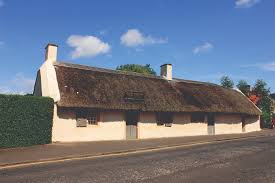
The cottage where Burns was born is on the site, as is the haunted church that inspired his famous poem“Tam O’Shanter,” the fifteenth century bridge Brig O’Doon that figures in the poem, and a beautiful memorial garden. The Burns Museum houses an amazing collection of artifacts and memorabilia associated with Burns. In the museum you begin to get an idea of the intensity and range of the Burns cult.
Following our second night in Ayr, we’ll drive south and east to two Burns sites on our way to Melrose. Ellisland Farm is a lovely, bucolic spot where Burns spent perhaps his happiest and most stable years. He built the farm himself, and today it is preserved in his memory. It was here that he composed “Tam O’Shanter” and other works. We’ll have time to walk around farm and along the river. After lunch at the farm and a recitation of Tam O’Shanter, we will drive a short ways to Dumfries, where Burns spent his final years, to visit the Burns House and his magnificent grave at the nearby St. Michael’s Church. In the late afternoon, the scenic drive from Dumfries to Melrose takes us into Sir Walter Scott country.
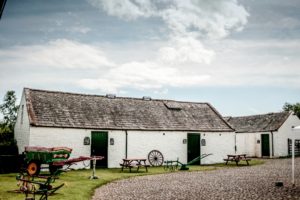
Readings
Any collection of Burns poems will remind you of how many of these you already know. Burns was an astute observer of human behavior, and he had a knack for pithy sayings that still creep into conversation over two hundred years later.
Many if not all of his poems have been set to music, and you will find many familiar tunes and lyrics. Youtube has a great collection, like this stunning version of “Green Grow the Rashes O” by Jean Redpath, my favorite interpreter of Burns.
Here is a handout of The Poetry of Robert Burns that I compiled. If you have any favorites you want the group to know about that aren’t on the handout, please let me know.
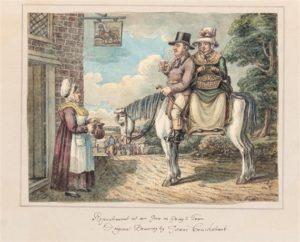
And here is a side-by-side translation (you’ll need it!) of Burn’s famous poem Robert Burns’s Tam O’Shanter.
Burns’s poetry is best as song, I believe. Listen to this stunning rendition of his “Green Grow the Rashes O” by Jean Redpath, my favorite interpreter of Burns. There are many recordings of his poems available on YouTube and elsewhere on line.
There are many biographies of Burns, but the best recent one probably The Bard by Robert Crawford (Pimlico 2010).
Films
Here are a few online films about Burns’s life.
Robert Burns: The People’s Poet (BBC)
Robert Burns: The Man and his Legends (Edge Hill Communications)
Tentative Itinerary
June 7 and 8, overnight near Ayr, Ayfordshire
June 8–Robert Burns Birthplace Museum, local Burns sites; free afternoon
June 9–Ellisand Farm for tour and lunch; Dumfries to see Burns house and grave; drive to Melrose and Sir Walter Scott country
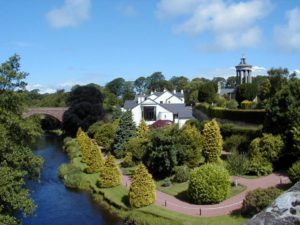

So glad we got to visit the Atlanta Burns Cottage ahead of the seeing the real thing.
After reading this when posted my first thought was, wait, we’re going to get to Scotland on a boat….across the Irish Sea??? I have done that before and I did not know enough to bring ginger pills. I won’t make the same mistake this time.
And then I thought, Burns is way more intriguing than I had anticipated.
I think the ferries are less rocky than they were back in my student days. I hope so! And yes Burns is a fascinating person for many reasons. For one thing, he was an advocate of democracy when it ws still a radical position in Great Britain.
Chris and I found the BBC documentary “Robert Burns: the People’s Poet” on YouTube and it was quite good. I am reading some of his poetry, 1-2 poems a day, as there are so many!!
I’m also attempting to read “Waverly” by Sir Walter Scott. It’s length is a bit daunting, but I persevere.
OK, Christine. You’ve got me! Burns sounds more interesting than I thought. Why did I ever doubt you?!
I won’t lead you astray, Anne-Marie!